 |
|
 |
|
|
|
|
|
|
|
|
|
|
|
|
|
|
|
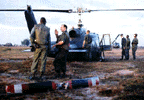 (click photo to enlarge)
(click photo to enlarge)Formation flying and in particular flying in Trail can be rather prone to "ruin your day"!!!
Reed Kimzey tells the story that goes with the above picture...."It was a rather routine resupply pick-up at the 25th DIV base camp at Cu Chi. This bird was number two in the flight (don't know how many were in the flight). The lead aircraft was a little hot and did a BIG deceleration at the end and the pilot of the bird shown (I honestly don't remember his name) stuck the tail rotor in the ground and knocked it and the gearbox off. When the bird started to spin, the pilot bottomed the collective and permanently "smiled" the skids. No one was hurt (except pride). The Bird did a full 180 degree spin before it hit the ground. I think that is my bird in the background."
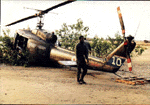 (click photo to enlarge)
(click photo to enlarge)How many times have you flown trail in a formation and when lead picked a spot to land, there was not enough room for all the birds. So, trail had to take what was left-over? Well, this story is about such a situation.
Reed Kimzey was flying trail when lead landed at Dong Tam with the flight. Trail was left with a spot that was very, very soft, almost quicksand, but this was not immediately evident. This was in late 1966 before Dong Tam was the sprawling base camp of the American 9th DIV and the LZ was not PSP.
Reed tells the story like this......"We landed at Dong Tam, and I was trail. We shut down and started for the briefing when I noticed that my aircraft was slowly being reclaimed by Mother earth!. The crew and I began cutting and throwing branches under the aircraft to keep it from settling to the belly. Since the major portion of the weight is over the rear of the skids the tail began to droop and was very close to the sand. So, we found a pallet to put under the stinger to keep the tail rotor from settling all the way to the sand."
"After some thinking and discussion, I got back in the cockpit and fired up Blue 10 and slowly and gently lifted the bird up, moved about 30 feet to one side and set it down....more solid and it stayed stable very nicely. I was concerned about mast bumping , but no problem. No other aircraft in the flight had any such problems with soft or quicksand."
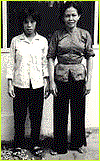
Vietnam was a place of many stories. I have thought about this story more than once over the last 32 years. I wonder how many multiple tour guys have a similar story.
Most aviators had two tours in Vietnam and no doubt the tours were as different as night and day. Normally, 2-3 years separated the tours. And ,the people you served with as well as the area you flew in was completely different. So were my two tours; one in 66-67 and again in 70-71. However, I did experience one person common to both tours.
Arriving in Bien Hoa in August 1966, my flight school classmate, Reed Kimzey and I were assigned to the 118th AHC and ended up as roommates in the "villa" on Cong Ly street,a civilian neighborhood within the city of Bien Hoa. Golly, this wasn't so bad! A clean room, mess hall with COLA and a neat bar. Trips to the flight line at the Bien Hoa Air base was via "acquired" USAF bus. Our room was about the size of a motel room and had a private shower and commode. Clothes were stored in the wooden clothes closet with the ever burning light bulb which had to be replaced often due to the varying house voltage provided by the generator down the street. But, at least we had electricity and sun heated water (eat your hearts out Cav guys!).
Probably the greatest luxury Reed and I had was a "hooch-maid"! She was typical; black pajamas, white long sleeved top, barefoot with thongs and of course the most beautiful black teeth!! I never really knew her name, except Mamma-san, until around Christmas. She left Reed and me a Christmas Card on our pillow which was signed very carefully with the name, "Mot Kha" I still have it in my memorabilia box.
Mot Kha (see picture above) was like a shadow as she arrived and quietly glided around the room making the beds, sweeping the floor with the usual wrapped-handle grass broom. She never talked or showed an expression , unless you said something. Then she would always grin with a big smile of those black teeth. Her day involved cleaning about 5-6 rooms, washing clothes and shining boots. Our fatigues (before jungle fatigues and flight suits) were taken out by Mot Kha and over a couple days were washed and starched(rice starch and washed in rice paddies, no doubt). They looked clean and pressed but, UGH! they smelled terrible!! Her highlight of the day was sitting with the other hooch-maids in a small group outside shining boots, visiting and chewing beetle-nut. Remember how they would listen to some guy's radio and talk and talk and talk all squatted about? Right after Christmas I transferred to the Gun Platoon, the Bandits, and lived in another part of the villa. I had a different hooch maid but, I don't remember her name.
Prior to my second tour, 70-71, I spent several years performing the obligatory instructing at Ft. Wolters, TX. I attended several schools prior to the return to Vietnam ,including Air Traffic Control Officers Course. Arriving in Bien Hoa and Long Binh in June, I was assigned temporarily to the 120th AHC at Long Binh for a couple months. A transfer to the 125th ATC Co. came through because of my between tour schooling and I soon arrived at the 125th Company area on the north side of the Bien Hoa Air base. I was assigned to quarters with an old head who was short and things were going well.
After I had been in the 125th ATC Co. for about a week I was walking to the mess hall which was about two blocks away. Walking past several groups of boot shining hooch-maids, the sight was familiar and almost unseen. Just before arriving at the mess hall, I glanced at a group of hooch-maids and guess what? I recognized one of them--it was Mot Kha!! Shocked, I stopped and walked up to the group and said ,"Mot Kha"! She looked up and her face went white as she yelled , "Di We", and jumped up grabbing me around the neck . She jabbered loudly and obviously was as excited as I was to see a familiar face from the past. The last thing I ever expected was to see someone, like her, from the first tour. I was, obviously, very glad that she didn't try to kiss me with those black teeth!
Well, while I was at Bien Hoa , Mot Kha had to be my hooch-maid. Everyday after she finished her usual hooch-maid duties several blocks away , she came to my room and did my work , too. The regular hooch-maid was not happy, because there was two of us in the room. Mot Kha usually arrived late in the afternoon and it seemed like old times.
Three years had brought changes not only in the war, but in the atmosphere of the Vietnam wartime society. Several times before I left Bien Hoa to transfer to Phu Bai and take over the 1st Platoon (later A Co.) of the 125th ATC, Mot Kha tried to sell me cocaine and heroine which she had never tried to do before. I declined, of course, and tried to ask her why she was peddling drugs. She never seemed to understand, or acted like she didn't. I never got an answer from her and decided not to press her for one. It was, however, still good to see Mot Kha and, she did the same good job as my hooch-maid three years before.
Vietnam had changed in the three years between my tours. The people were different. We were different, too. The society and the people had changed. Free enterprise had taken over and drugs were rampant. An innocence was gone and I was sad. Over the years, I have wondered if Mot Kha is still alive and what she might be doing. Maybe, someday I can go back and walk the streets of Bien Hoa to see if she is still there--black teeth and all!

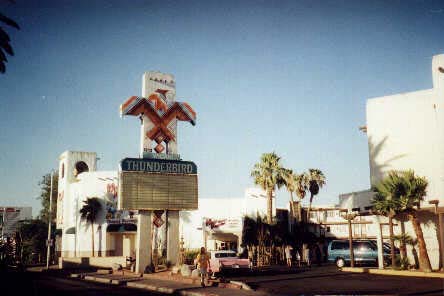
|
|
|
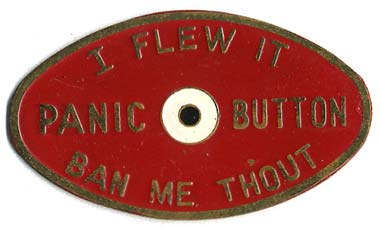
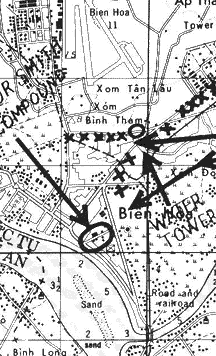
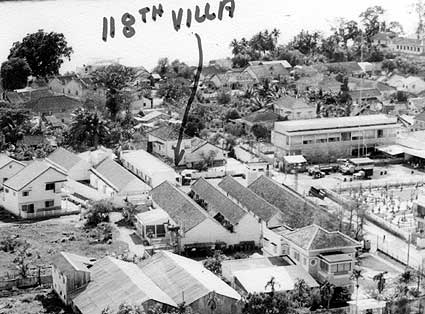
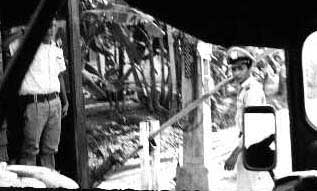
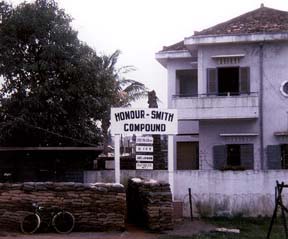
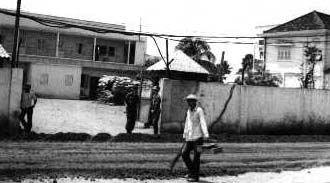
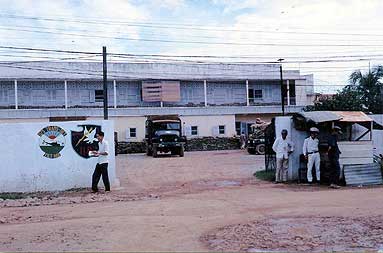
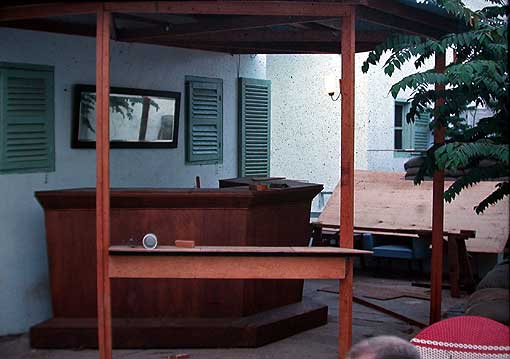
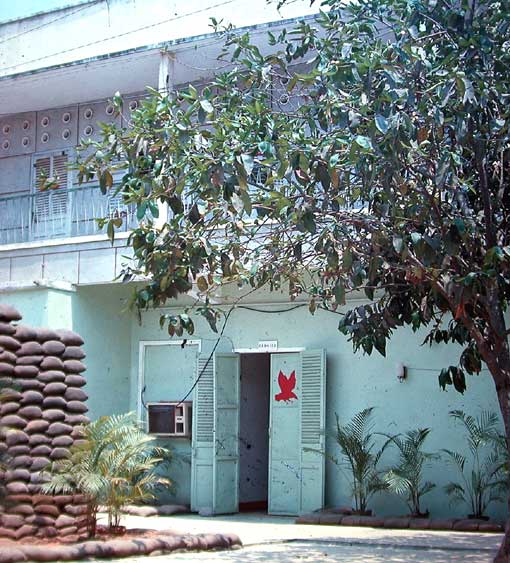
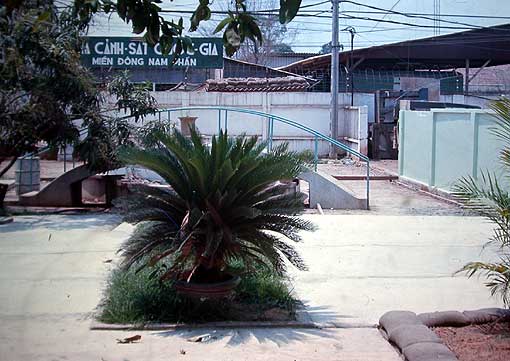

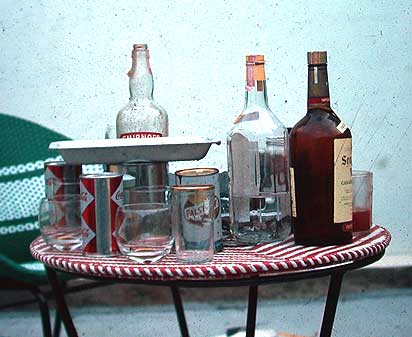
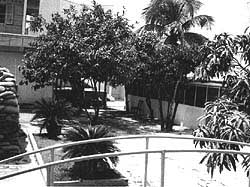

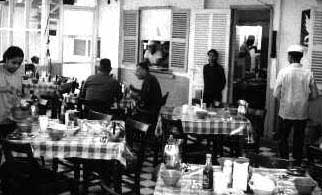
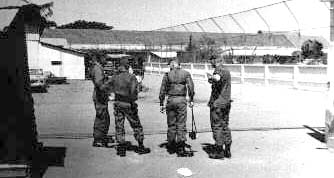
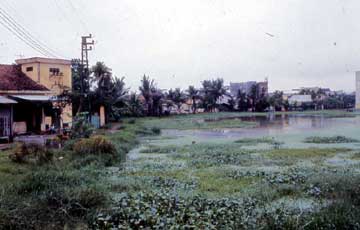
| Tom Payne remembers: "I was just finishing up Advanced training at Ft. Wolters, TX. As a married 2LT officer, I had been able to obtain family housing on Ft. Wolters and we lived at 313 Magruder in a duplex. In the other side lived 1LT George I. Jones who was an IP, and his wife Sue. On 19 February, 1966, I returned from flying in the afternoon and my wife told me that our next door neighbor, 1LT George Jones' sister had been killed in a helicopter accident in Vietnam. She was a nurse and her name was ELIZABETH ANN JONES! It was a very hard time. I remember it was then that Vietnam and the dangers I would be facing soon began to soak in. Little did I suspect that a mere 6 months later I would be living in Honour-Smith Compound on Cong Ly street in Bien Hoa, Vietnam." |